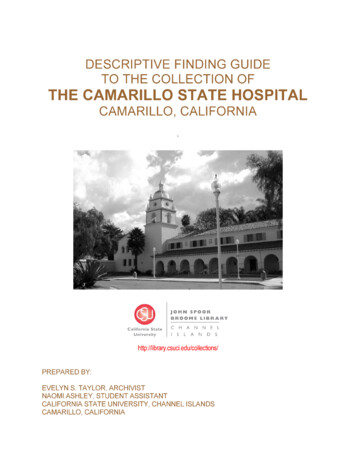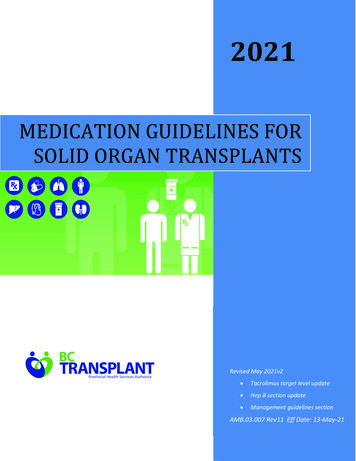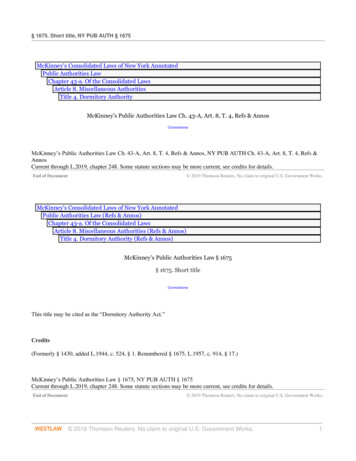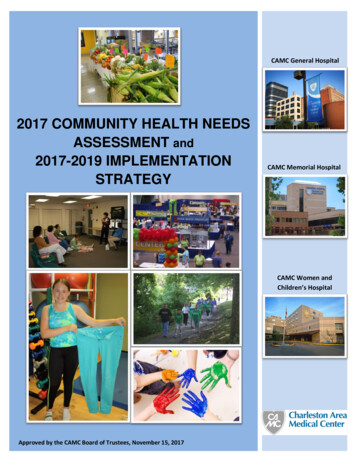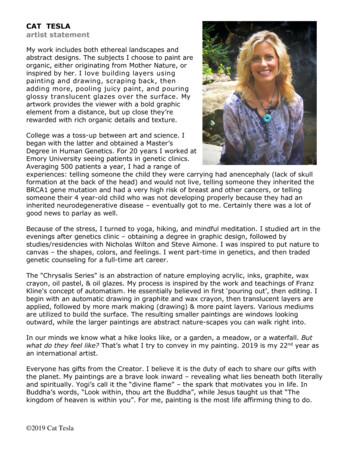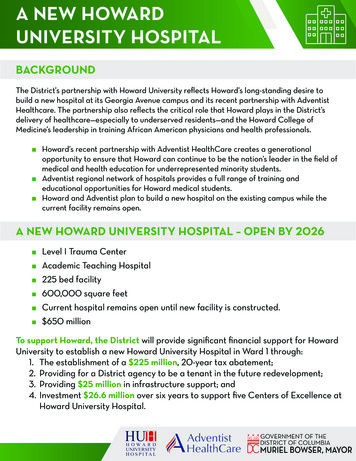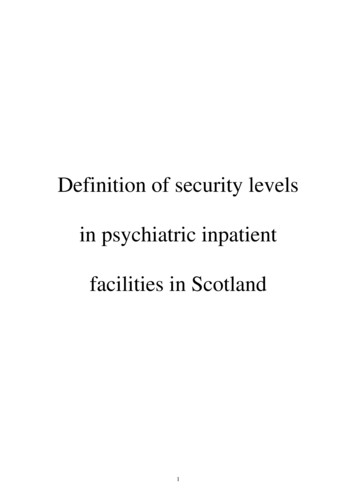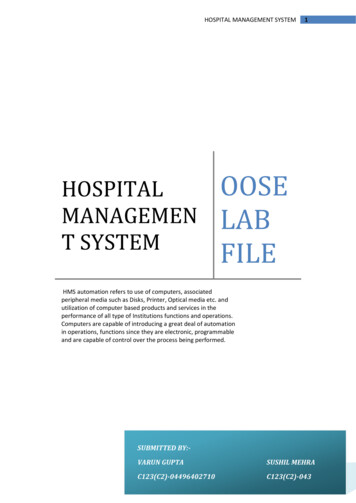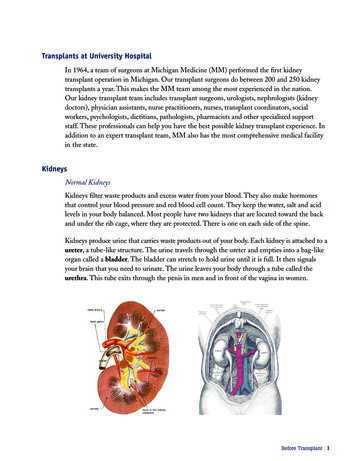
Transcription
Transplants at University HospitalIn 1964, a team of surgeons at Michigan Medicine (MM) performed the first kidneytransplant operation in Michigan. Our transplant surgeons do between 200 and 250 kidneytransplants a year. This makes the MM team among the most experienced in the nation.Our kidney transplant team includes transplant surgeons, urologists, nephrologists (kidneydoctors), physician assistants, nurse practitioners, nurses, transplant coordinators, socialworkers, psychologists, dietitians, pathologists, pharmacists and other specialized supportstaff. These professionals can help you have the best possible kidney transplant experience. Inaddition to an expert transplant team, MM also has the most comprehensive medical facilityin the state.KidneysNormal KidneysKidneys filter waste products and excess water from your blood. They also make hormonesthat control your blood pressure and red blood cell count. They keep the water, salt and acidlevels in your body balanced. Most people have two kidneys that are located toward the backand under the rib cage, where they are protected. There is one on each side of the spine.Kidneys produce urine that carries waste products out of your body. Each kidney is attached to aureter, a tube-like structure. The urine travels through the ureter and empties into a bag-likeorgan called a bladder. The bladder can stretch to hold urine until it is full. It then signalsyour brain that you need to urinate. The urine leaves your body through a tube called theurethra. This tube exits through the penis in men and in front of the vagina in women.Before Transplant 1
Kidney Failure Leading to TransplantationWhen your kidneys are unable to perform their normal functions you have kidney failure, alsoknown as renal failure. Some of the primary causes of end stage kidney failure include: Diabetes mellitus Hypertension Glomerulonephritis Hereditary diseases like polycystic kidney disease or Alport’ssyndrome Metabolic diseases or inborn errors of metabolism like oxalosis orcystinosis Obstructive uropathy Medication toxicities Multisystem diseases like vasculitis, amyloidosis or systemic lupus erthymatosus Congenital malformations including vesical ureteral reflux, hypoplasia or dysplasia Other forms of irreversible acquired renal failureDiseased kidneys do not do a good job of filtering toxins or removing water from the body.To stay healthy, people with diseased kidneys will need dialysis or a kidney transplant. Kidneytransplantation improves the length and quality of life of people whose own kidneys have failed.The Kidney TransplantYour transplanted kidney will beplaced in your pelvis above thegroin area. Your native kidneys donot normally need to be removedand therefore remain in yourbody. The incision for a kidneytransplant is approximately four to12 inches long and is located onthe lower abdomen on the rightor left side. The operation usuallylasts two to four hours. After thetransplanted kidney is connected2 Before Transplant
to your blood supply, the transplanted kidney usually begins to make urine. The transplantedureter is attached to your bladder. As the new kidney begins to work filtering waste productsfrom your body, you will begin to feel better.Kidneys for Transplantation – Where Do They Come From?All kidneys available for transplantation are a result of a gift from one person to another.Kidneys can come from either deceased or living donors.Deceased Donor KidneysDeceased donor kidneys (and other organs) are donated after the death of the donor. Thesuitability of the donor is determined by many factors. These include many of the samecriteria used for living donors such as medical history, general health, habits and so forth.As of November 2019, there were 94,000 persons awaiting a kidney transplant on the waitlist in the United States. At the University of Michigan alone, there are nearly 800 patientswaiting. Unfortunately, in the year 2018 only 21,167 kidney transplants were performed inthe United States. In 2014, 4,761 persons died waiting for a transplant. Because of a severenational organ shortage, alternative solutions to using deceased donor organs have been sought.Donation After Brain Death (DBD)Most deceased organ donors are brain dead. They have suffered complete and irreversibleloss of all brain function, and are clinically and legally dead. Mechanical ventilation andmedications keeps their heart beating and blood flowing to their organs.Donation After Cardiac Death (DCD)Some people with non-survivable injuries to the brain never become brain dead because theyretain some minor brain stem function. If such individuals made the decision to be donors ortheir families are interested, organ donation may be an option. Donation in such cases involvestaking the patient off the ventilator, typically in the operating room. Once the patient’s heartstops beating, the doctor declares the patient dead and organs can be removed.Increased-Risk DonorsSome donors have been determined to have increased-risk behaviors such as IV drug abuse,long-term stay in a correctional facility, prostitution, etc. (either now or in the past). Thesedonors are determined to be at increased risk of transmission of certain diseases (i.e., HIV,hepatitis C, hepatitis B) to a recipient. All donors, whether they are increased-risk or not,are tested for disease. These tests can detect a donor infection as recently as one week ago.Before Transplant 3
The results of these tests are back before the organs are donated. Increased-risk donors whotest negative and are not now engaging in increased-risk behaviors carry a very low risk oftransmission of infection and are therefore used as kidney or pancreas donors. The true riskof transmission is not known but is probably much less than one percent. If a kidney from aincreased-risk donor is offered to you, this will be discussed with you at the time of the offer.While we generally recommend accepting such an offer, you will have the option to accept ordecline.Kidney AllocationQuestions and Answers for Transplant Candidates About the Kidney Allocation SystemUnited Network for Organ Sharing (UNOS) is a non-profit charitable organization thatmanages the nation’s transplant system – known as the Organ Procurement and TransplantationNetwork (OPTN) – under contract with the federal government. As the OPTN, UNOS helpscreate and define organ sharing policies that make the best use of donated organs. This processinvolves continuously evaluating new advances and discoveries so policies can be adapted to bestserve patients waiting for transplant.The kidney allocation system was revised in 2014 as a result of years of review and consensusbuilding among transplant professionals and people who have personal experience withdonation and transplantation. Their primary goal was to make the system better withoutmaking major changes to the parts of the systems that work well.The policy as implemented addressed a number of goals to promote organ utilization andequity, notably: Improving utility by better matching estimated length of kidney function to estimated timea candidate may need a transplanted kidney Enhancing equity by basing transplant waiting time on dialysis, rather than the previousmethod of beginning waiting time at listing with a transplant hospital Increasing transplant opportunities for highly immunosensitized candidates by providingthem additional priority, especially those with a CPRA score of 98 or higher Increasing transplant opportunities for blood type B candidates (many of whom are ethnicminorities) by facilitating kidney offers to them from donors with blood subtype A2 Broadening distribution of shorter-longevity kidneys to increase their utilizationMore than four years after KAS implementation, the system continues to shape access totransplantation nationwide. UNOS will continue to study the system closely to make sure itis performing as expected. UNOS will address any issues that suggest that the policy is notmeeting needs, or if other issues arise.4 Before Transplant
How Are Kidneys Classified?Every kidney offered for a transplant has a Kidney Donor Profile Index (KDPI) score. This isa percentage score that ranges from zero to 100 percent. The score is associated with how longthe kidney is likely to function when compared to other kidneys. A KDPI score of 20 percentmeans that the kidney is likely to function longer than 80 percent of other available kidneys. AKDPI score of 60 percent means that the kidney is likely to function longer than 40 percent ofother available kidneys.If you have been listed for some time, you may have heard of a kidney being classified as“standard” or “expanded criteria.” These classifications are no longer used.What Goes Into a KDPI Score? Age Height Weight Ethnicity Whether the donor died due to loss of heart function or loss of brain function Stroke as cause of death History of high blood pressure History of diabetes Exposure to the hepatitis C virus Serum Creatinine (a measure of kidney function)How Will Transplant Candidates be Classified?Each kidney candidate will get an individual Estimated Post-Transplant Survival (EPTS)score. This is a percentage score that ranges from zero to 100 percent. The score is associatedwith how long the candidate will need a functioning kidney transplant when compared toother candidates. A person with an EPTS score of 20 percent is likely to need a kidney longerthan 80 percent of other candidates. Someone with an EPTS score of 60 percent will likelyneed a kidney longer than 40 percent of other people. Your transplant team can calculate yourEPTS score for you.Before Transplant 5
What Goes Into a EPTS Score?The EPTS is calculated based on facts about the candidate that affect how long you are likelyto need a kidney. These factors include: Age Length of time spent on dialysis Having received a previous transplant (of any organ) Current diagnosis of diabetesHow Will the KDPI and EPTS Scores Be Used in Allocating Kidneys?The 20 percent of kidneys that are expected to last the longest – those with a KDPI score of20 percent or less – will first be offered to patients likely to need a transplant the longest –those with an EPTS score of 20 percent or less. If a kidney with a KDPI of 20 percent or lessis not accepted for any of these patients, it will then be offered to any other person who wouldmatch, regardless of their EPTS score.Kidneys with high KDPI scores are expected to function for a shorter amount of time thanothers. They may be best used to help candidates who are less able to stay on dialysis for a longtime. The 15 percent of donated kidneys likely to function the shortest time (those with a KDPIgreater than 85 percent) will be offered first to a wider area of the country than other kidneys.The goal is to encourage use of these kidneys by finding suitable patients as quickly as possible.Your transplant team can discuss with you the best options for matching based on you EPTSscore and the types of kidneys that would best meet your need.What Will Change for Hard-to-match Patients?Some patients are hard to match with most kidney offers. There are a couple of options topossibly help decrease a patient’s wait time.In some cases, people have developed immune system responses that make it very difficult tofind a kidney their body won’t reject. This may happen because of having a previous transplantor blood transfusions, or even from pregnancy. People who are “highly sensitized” often waitfive or more years before receiving even one kidney offer.The allocation system gives highly immune sensitized candidates more priority for kidneysthey aren’t likely to reject. People who have a slightly higher sensitivity get slightly morepriority. People who are very highly sensitized (98 percent or above) get much more priority.Kidneys that are offered first to highly sensitized candidates, but don’t get accepted for them,are then offered to other patients.6 Before Transplant
Your transplant team can discuss with you whether you are sensitized and, if so, the additionalpriority you would receive for matching kidneys.Another option to help reduce wait time is for people with blood type B. People on thedeceased donor waitlist that are blood type B often wait longer for a kidney than people withother blood types. This in part because it is harder to find a donor with type B blood.For these recipients, they may be able to receive a donor kidney from a donor that is blood type A.Donors with blood type A generally can’t donate to a person with blood type B. However,some blood type A donors have a “subtype” that allows them to match a type B candidate. Thesystem gives first priority for these donor kidneys for type B patients. Since blood type A donorsare more common than blood type B donors, more offers should be available for type B.Your transplant team will discuss this option with you if you are blood type B.How is Waiting Time Calculated?If you are listed for a transplant before you begin dialysis with a medical definition of kidneyfailure (having a creatinine below 20 ml/minute), your waiting time will start the day youare listed.If you began dialysis before you were listed for a transplant, you waiting time is calculatedfrom your dialysis start date. This is the most objective and consistent way to measure whenyour need for a transplant began.A transplant program may evaluate you and list you for a transplant even before you startdialysis. If you are listed early, you can be matched for a deceased donor kidney based onmedical matching criteria in the kidney allocation policy. You would not receive additionalpriority for waiting time until you either start dialysis or have kidney failure.What if I’m Not Listed for a Transplant But Want to Be?Talk to your doctor about your current health and your treatment options. If you want to beconsidered for a kidney transplant, it would be best to get evaluated and listed by a transplanthospital when, or just before, you start dialysis or reach end-stage kidney failure. This willallow you to be considered as early as possible for a kidney offer.For More InformationStart with your doctor or the medical team at your transplant center. They know the mostabout your specific medical conditions and treatment. Don’t be afraid to ask questions. It willhelp you to have a detailed understanding of all your treatment options.Before Transplant 7
UNOS’ Patient Services phone line [(888)-894-6361] can provide information aboutthe OPTN and UNOS allocation policy and other resources available to you. Additionalinformation is available online on the following websites:www.transplantliving.org optn.transplant.hrsa.gov www.unos.org srtr.org The UNOS mission is to advance organ availability and transplantation by uniting andsupporting its communities for the benefit of patients through education, technology andpolicy development.Living Kidney DonationThere are several advantages for a transplant candidate receiving a living kidney transplantas opposed to receiving a kidney from a deceased donor. The major advantage is that therecipient does not have to wait as long for a transplant. In some cases the transplant can occurbefore the patient begins dialysis. Another advantage of living donor kidney transplantationis that it can give patients the chance to receive a transplant before the onset of debilitatingcomplications of their kidney disease, or before they become too ill to have a transplant. Aliving donor can come from either a direct donation or through our paired program. Donorsdo not need to be compatible to donate. Please see the living donor kidney transplant sectionfor complete information on the process and options for living donation.PancreasNormal Pancreas FunctionYour pancreas is a gland near the stomach that supplies the intestines with digestive fluid andsecretes insulin. Insulin is a hormone regulating the amount of glucose in the blood. A lack ofinsulin causes diabetes.8 Before Transplant
Pancreas TransplantationPancreas transplantation may be performed on patients with Type 1 diabetes mellitus sothat the complications of Type 1 diabetes mellitus can be avoided, halted or delayed. It canprevent life-threatening hypoglycemia (low blood sugar). Since severe Type 1 diabetes is oftenassociated with chronic kidney failure, many patients who need a pancreas transplant alsoneed a kidney transplant. The major difference between kidney and pancreas transplants isthat while kidney transplants can be expected to significantly prolong the lives of recipients,the same is not true for pancreas transplant recipients. Therefore, for pancreas recipients, theremust be a reasonable expectation that your quality of life will be improved.Pancreas transplant can be performed in one of three different operations depending uponyour needs. Since severe Type 1 diabetes is often associated with chronic kidney failure; manypatients who need a pancreas transplant also need a kidney transplant.The operations for pancreas transplant include:Simultaneous Pancreas Kidney Transplant (SPK) A simultaneous pancreas kidney transplant is an operation that transplants a kidney anda pancreas during one operation. This option is selected when you have Type 1 diabetesmellitus and are at or near end stage renal failure.Before Transplant 9
Pancreas After Kidney (PAK) A pancreas transplant after kidney transplant is done if you need a pancreas and havealready had a successful kidney transplant. You must be stable and at least three monthsafter your kidney transplant. This is typically done if you have Type 1 diabetes mellitus andalready have a kidney transplant.Pancreas Transplant Alone (PTA) A pancreas transplant alone is done when you have Type 1 diabetes mellitus with lifethreatening high or low blood sugar that is unresponsive to maximum medical managementand insulin therapy. Patients who receive PTA do not have kidney disease. Your transplanted pancreas will be placed in your pelvis through an incision that startsabove your belly button and extends down to in front of the bladder. Your native pancreasis not removed and therefore remains in your body. After the transplanted pancreas isconnected to your blood supply, it usually begins to make insulin and the blood sugar levelsbecome normal. The pancreas is then attached to your intestine so that fluid made by thepancreas that aids digestion can drain into it. The pancreas transplant operation usuallylasts two to four hours but if it is combined with a kidney transplant it can take three tosix hours.Some Patients Cannot be Listed for a Pancreas TransplantPancreas transplantation is not usually done in patients with Type 2 diabetes mellitus.Although these patients may have trouble making enough insulin, they also have a decreasedsensitivity to the use of insulin. Insulin resistance is a problem that a pancreas transplantcannot correct. These patients would continue to require insulin even if they received apancreas transplant.Pancreas for Transplantation - Where Do They Come From?All organs available for transplantation are a result of a gift from one person to another. Allpancreas transplants come from deceased donors.Deceased Donor Pancreas Each pancreas is donated after the death of the donor. The suitability of the donor isdetermined by many factors. These include many of the same criteria used for living donorssuch as medical history, general health, habits and so forth.10 Before Transplant
The facts about pancreas transplant as of November 2019 include:Persons Awaiting TransplantPancreasKidney/PancreasPersons in U.S. awaiting a transplant8271,651Persons at MM awaiting a transplant616Number of transplants in U.S. in 2018192835The Immune SystemThe job of the immune system is to fight infections and to keep us from getting cancer. Theimmune system does this by recognizing antigens, which are small particles found on the surfaceof all cells of the body, viruses and bacteria. The cells of your body have the same antigens thatyour immune system has. Your immune system leaves them alone. A cancer, a virus or bacteria,or transplanted tissue may not have the same antigens as your immune system. The immunesystem will attack these “foreign” antigens and make antibodies against them.Understanding the Immune SystemWhat is an Antigen?An antigen can be a “self ” or “foreign” protein. When the immune system recognizes anantigen as “foreign” it will develop antibodies specific to the antigen.What are Antibodies?Antibodies are proteins formed by the immune system of the “self ” in response to the “foreign”antigen. They function to neutralize the antigen. When they interact, a reaction occursthat can cause destruction of tissue. When the antigen is present in a kidney transplant, thereaction between antibodies and antigen can cause rejection.How Antibodies DevelopPeople can develop antibodies to foreign antigens after being exposed through a pregnancy,transfusion, infection or transplant. If any of these happen to you, it is important that you senda blood sample to the tissue typing lab within seven to 14 days of the event. To request a kit(a tube and packaging material), call the tissue typing lab at (734) 647-2774 and ask for apost-transfusion sample kit. Take this to your local lab and have your blood drawn. Then, mailthe specimen back to MM and let your coordinator know.Before Transplant 11
Understanding the Matching ProcessWhat is Matching? hen we speak of a donor and a recipient as being a “match,” it really means that their bloodWgroups are compatible and that they have a negative crossmatch. Your coordinator can answerany questions that you may have.Blood TypesA suitable donor has a compatible blood type with the recipient. Human blood types are O,A, B and AB. The Rh factor, positive or negative, is not part of kidney or pancreas matching.Once it is known that your blood type is compatible with your donor, we obtain blood samplesfrom both of you to determine your tissue types and crossmatch.What is Tissue Typing?Your white blood cells, also called leukocytes, have a special group of antigens on them calledHuman Leukocyte Antigens or HLA. Tissue typing is how we find out which ones you have.This is necessary information to have before a person can receive a kidney transplant.Each person inherits two sets of HLA, one from each parent. Each set is called a haplotype.A haplotype contains three antigens. Brothers and sisters also have one haplotype fromeach parent. This is why parents and siblings have a better chance of a close match, than dounrelated donors. If two siblings have all six antigens exactly the same, then we call this atwo-haplotype match. When the donor is not related to the recipient, the tissue typing termschange. Antigen matching is then expressed by the number of antigens out of six that are thesame for the donor and the recipient. While there is some advantage in having a well matcheddonor, any healthy compatible donor is a “good donor” and the odds of a good result are high.What is Crossmatching?Crossmatching is done after blood and tissue typing are completed and a donor is identified.This test checks to see if the recipient has developed antibody against the donor. A smallamount of the recipient’s blood is mixed with the potential donor’s white cells. If antibodiesin the recipient’s blood attach to the donor white cell antigens, the white cells are injured.This is called a positive crossmatch. This means that if a transplant took place between thisrecipient and donor, the recipient’s immune system would attack the transplanted tissue. Thecrossmatch must be negative for the transplant to be done.12 Before Transplant
What is Antibody Screening?Antibody screening is also called PRA (panel reactive antibody). This test can tell us ifthere are antibodies that a recipient has that would cause a reaction against certain donors.Recipients can be exposed to different antigens through blood transfusions, other transplantsor pregnancy. The body then protects itself from these “foreign” exposures mentioned aboveand makes antibodies. The body does not want to see that specific foreign antibody again or itwill attack it. For example, if we transplanted a kidney with that specific foreign antibody, thebody would attack that kidney. Antibody screening is performed monthly while the recipientis listed. This is done to monitor for any changes in the PRA level. The PRA score is given asa percentage and can be from 0% to 99%. The higher the PRA level, the harder it is to find acompatible kidney for the recipient.Pre-Transplant EvaluationReferral Process for a Transplant EvaluationPatients may be referred by any doctor or patients may also refer themselves.Pre-Transplant Evaluation Appointment kidney and/or pancreas transplant evaluation is actually a series of visits with severalAdoctors and other members of the transplant team, all occurring on the same day. Thisappointment will take four to eight hours. During the initial evaluation appointment you willsee a transplant coordinator, a physician assistant or nurse practitioner, a nephrologist (kidneydoctor), a surgeon, a social worker and a dietitian. Each member of the team has a specific rolein the evaluation process. Please refer to the Transplant Team section of this guide for furtherinformation.On the day of evaluation you will attend a patient education class for patients and familiesof potential kidney and/or pancreas recipients and potential living kidney donors. There is awealth of information shared during the evaluation appointment and the patient educationclass. We require you to bring a support person to be with you throughout the evaluation dayto take notes and ask questions. our evaluation appointment will include a history and physical exam in addition to otherYtesting. After all the test results are compiled, the transplant team will meet to discuss whethertransplantation is an appropriate treatment option for you. It is important to remember thatyou are NOT listed for a transplant at the end of your evaluation appointment.Before Transplant 13
Selection CriteriaWritten criteria specific to each organ are used in evaluating all individuals who present fortransplantation. The criteria include a) the indications for transplantation, b) the relativecontraindications for transplant, and c) the absolute contraindications (if there are any). Pleaserefer to “Selection Criteria” at the end of this section.Tests and Procedures During EvaluationInitial TestingThe following is a list of preliminary testing that can be expectedin order to determine if you are an appropriate candidate for kidneyand/or pancreas transplant. Many times all of the testing below can beaccomplished on the day of evaluation. A complete history and physical exam to evaluate your general health is performed.It is very important that you be completely honest with us about your health history. Blood studies will include blood chemistries, blood counts, blood type, immune systemfunction and tests for certain infectious diseases. A chest X-ray is taken to determine the health of your lungs and respiratory tract.An EKG of your heart is done. Further diagnostic testing of your heart may benecessary, such as a stress test or cardiac catheterization.Additional testing may be necessary depending on your individual medical history.Additional TestingOften the results of one test lead the team to request additional testing. When thisoccurs, the results from the additional testing are necessary before the team can make adetermination about your candidacy for transplant. The transplant team wants to ensure youare as healthy as you can be for your transplant and that you will benefit from a transplant.When additional tests are ordered, they can often be done by your primary care physicianor local lab. Occasionally, we require a specific test be completed at a MM facility. You willreceive written instructions for the tests that are needed.14 Before Transplant
I f you are asked for additional testing, do not be discouraged. Most people who get listed andtransplanted are asked to have additional testing after their initial evaluation. or additional information, see “Summary of Tests for Kidney and Pancreas TransplantFPatients” on page 45 of the Resources section.Testing Complete – Results ReportedIt is important to note that all requested testing must be completed and the results mustbe obtained by the transplant team in order for your case to proceed to be reviewed at theevaluation meeting. Failure to complete the testing or get the results submitted canlead to delays in the process.Health and Social Considerations for ListingSmoking Policy obacco use constricts the blood vessels, compromises blood flow to the extremities andTis a risk factor in coronary artery disease. Transplant recipients who smoke and/or usesmokeless tobacco products have worse survival of their transplant. They also have higherrisks of infection and of developing cancer. Going through tobacco withdrawal at the time ofsurgery is an unnecessary stress. The Michigan Medicine campus environment is smoke-free,therefore, no smoking is permitted on the grounds.Transplant candidates are recommended to stop smoking and/or using smokeless tobaccoproducts before transplant and to maintain abstinence from tobacco products after transplant.Smoking cessation assistance can be received through your primary care physician or throughyour transplant social worker. Available smoking cessation programs include: MM Tobacco Consultation Service(734) 998-6222quitsmoking@med.umich.edu Michigan Tobacco Quitline(800) QUIT-NOW, (800) 784-8669 SmokeFree.govA text messaging program for smoking cessationBefore Transplant 15
Alcohol and Drug Policy lcohol an
score. This is a percentage score that ranges from zero to 100 percent. The score is associated with how long the candidate will need a functioning kidney transplant when compared to other candidates. A person with an EPTS score of 20 percent is likely to

